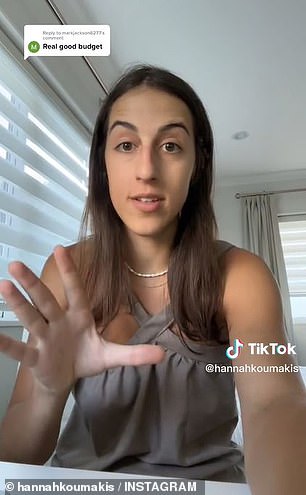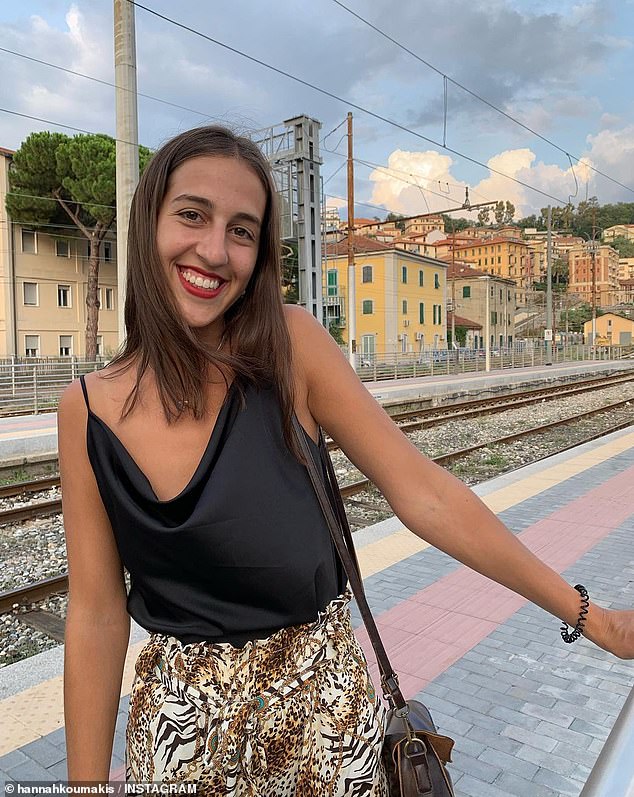Teaching kids about money: New Zealander Hannah Koumakis says she was paid $200 in pocket money
>
A former babysitter says she and her two older sisters received $200 each as pocket money every month, but they had to earn it and weren’t allowed to spend it all at once.
From the age of eight, New Zealand’s Hannah Koumakis was rewarded with pocket money for completing daily chores around the house and had to divide the funds into four separate categories: long-term and short-term savings, spending, and tithes to the Church. local.
The 23-year-old said the money would have been equivalent to $150 “in the past” due to inflation and the difference in current cost of living.
“At the age of eight my parents decided ‘you know what we want to teach kids to be really good with money,'” Hannah said on a TikTok. video.
‘Instead of buying us the things we wanted, they were going to show us how we can do it. We had daily chores.
scroll down for video

From the age of eight, Hannah Koumakis, from New Zealand (pictured), received $200 in pocket money each month to complete daily chores around the house and had to divide the funds into four separate categories.

On TikTok, Hannah detailed how they each had to set aside 30% of the money for long-term savings, 30% for short-term savings, 10% for tithing (money going to the local church), and the remaining 30%. . penny was to spend
‘They gave us $200 of pocket money, but back then it was $150, so let’s use $150. We don’t just get $150 a month to SPEND. No. We had to teach ourselves the power to save,” Hannah continued.
He detailed how each was to set aside 30 percent of the money for long-term savings, 30 percent for short-term savings, 10 percent for tithing (money going to the local church), and the remaining 30 percent. it was to spend
Hannah explained that the long-term savings fund was essentially money to buy a house.
“Since I was eight years old I was saving for my first house and I was SO excited to see it grow in my bank account,” he said.
‘We are Christians and we believe in paying tithing, so we also had to pay 10 per cent of our income to tithe, which leaves us with the remaining 60 per cent.
But they still couldn’t use the full remaining amount.
“We had to save another 30 percent for our short-term savings, anything to do with buying a big-ticket item like a car or laptop.”
The remaining 30 percent was allocated to your expenses, but there’s a catch.
‘Keep in mind that we had to buy everything, we had to buy our clothes. If we needed a new cap, we had to buy it ourselves,” Hannah said.
“Luckily, I was the third child, so I had a lot of second-hand clothes, but my sisters decided to get a little money from me to sell me their clothes.
“Every time we wanted a new Barbie doll, we never went up to our parents and scolded them, we literally had to save her.” [for] Ourselves.
‘My parents went from being, ‘No, you can’t buy this’ to ‘Yes, you can buy this, but do you have enough money?’
Other than the expense account, Hannah and her sisters were not allowed to touch the other funds.
“This means that, from the age of eight, I literally craved sales and made sure I was getting more for my money,” he said.
The three brothers were paid until the age of 13 and then began to earn money with odd or part-time jobs.

“Every time we wanted a new Barbie doll, we never went up to our parents and scolded them, we literally had to save her.” [for] ourselves,” Hannah said, adding, “My parents went from being, ‘No, you can’t buy this,’ to, ‘Yes, you can buy this, but do you have enough money?’
In retrospect, Hannah called the teaching method the ‘best system ever’ because it taught her so much about money.
“Now I really understand and have a great appreciation for money,” he said.
To keep track of his finances, he kept a ledger and made notes of everything he bought and when.
Since then, the detailed TikTok video has been viewed more than two million times and thousands praised Hannah’s parents for the clever method.
‘I LOVE THIS! I wish I would have been that polite,’ wrote one person, another said: ‘Your parents are brilliant! They should teach a class for other parents, or write a book!!! Wow!’
But some commented on how privileged Hannah and her sisters were to receive such a large amount of money each month.
“My parents made $1000 a month, imagine if they had to give me and my sister 200 haha,” one person commented.
Another said: “Great idea, but most parents don’t have 150 to spend on food, so you were lucky to have parents who could afford that lesson.”
